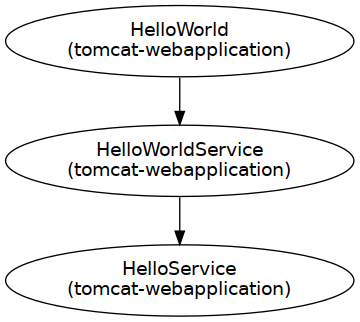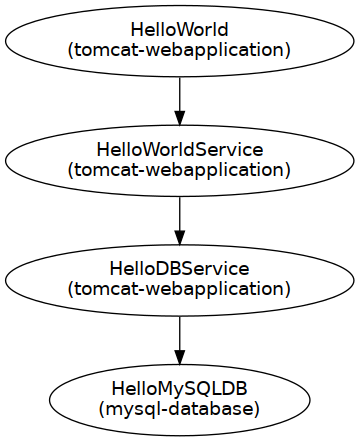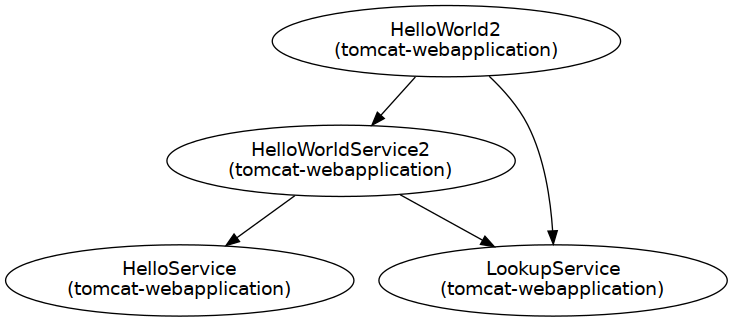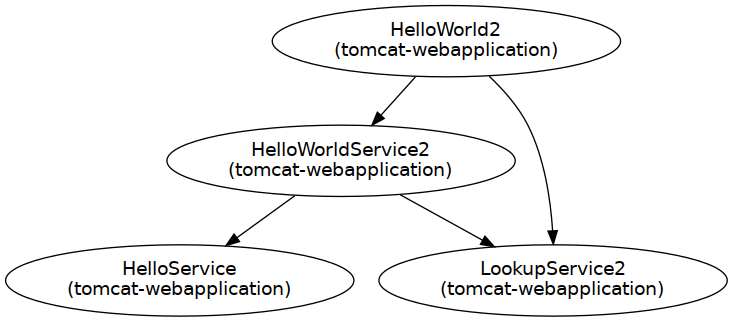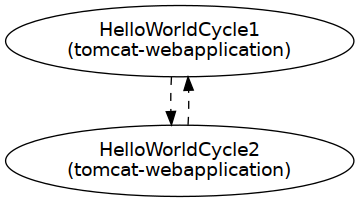disnix-composition-example
This is a trivial example case demonstrating various ways to compose services together. The simplest composition is done by just inheriting the dependency with the same name from the same lexical scope. Another example demonstates an alternative and more complex composition of the same service.
For each upgrade, services must be rebuilt (because the contents of configuration files change) which makes upgrades expensive in some cases. This example also demonstrates two variants to dynamically compose services together, so that in case of an event in which the location changes no rebuilds are required.
Architecture
We have several architecture variants in this example. What all variants have in
common is that they have a HelloService, a web service returning the string:
'Hello', a HelloWorldService web service, which attaches the string ' world!'
to 'Hello' and a web application front-end displaying the result.
Simple variant
The above figure shows the architecture of the simplest variant of this example.
In this architecture a HelloService component is shown which returns the string
'Hello'. The HelloWorldService retrieves the 'Hello' string to generate the
sentence: 'Hello World!'. The HelloWorld web application displays the result.
Alternative variant
The second figure shows an architecture using an alternative composition -- in
this variant, a web service called HelloDBService is used retrieving the Hello
string from a MySQL database instead of the ordinary HelloService.
Lookup variant
The third variant shown in dynamically binds service together using a
LookupService which knows about the locations of all services. The architecture
uses different variants of the web application front end and the
HelloWorldService which are lookup service aware. By using a lookup service no
rebuilds are required of all the other services (except when the location of the
lookup service changes).
Load balancing variant
The fourth variant uses a load balancer using the round-robin scheduling method to forward request to multiple instances of the same service, to achieve a simple form of load balancing.
Cyclic variant
This variant composes two services together that are mutually dependent on each other. To allow such kinds of deployments, we must use a special attribute in the Disnix deployment system specifying that the activation order does not matter.
Both services are servers and clients at the same time. They consult each other to obtain the 'Hello world!' message and display the result.
Deployment with container services
Another variant that deploys, in addition to the application services (the databases and the Java web applications), also the required container services (the MySQL DBMS and Apache Tomcat server).
It relies on the presence a Git checkout of the experimental Nix process management framework residing in the same base directory as this repository.
Extreme reuse optimised variant
All the web services embed their own private copy of the Axis2 web service container resulting in quite a bit of dependency duplication. It is also possible to deploy the Axis2 web application as a reusable container and use Disnix to embed each Axis2 application archive in it.
Similar to the previous example, this example relies on the presence of the experimental Nix process management framework.
Usage
The deployment/DistributedDeployment contains all neccessary Disnix models,
such as a services, infrastructure and distribution models required for
deployment. The optimised deployment variant models reside in the
deployment-optimised/DistributedDeployment directory.
Deployment using Disnix in a heterogeneous network
For this scenario only installation of the basic Disnix toolset is required. First, you must manually install a network of machines running the Disnix service. Then you must adapt the infrastructure model to match to properties of your network and the distribution model to map the services to the right machines.
To deploy the databases you must install MySQL. To deploy the web services and web application services you must install Apache Tomcat. Check the instructions of your Linux distribution or the software distributions themselves how to install these system services. Dysnomia detects the presence of these system services and configures the corresponding modules to use them.
The system can be deployed by running the following command:
$ disnix-env -s services-simple.nix -i infrastructure.nix -d distribution-simple.nixThe service-simple.nix and distribution-simple.nix files can be replaced by
the models for the other variants, such as service-lookup.nix.
Deployment using the NixOS test driver
This system can be deployed without adapting any of the models in
deployment/DistributedDeployment. By running the following instruction, the
variant without the proxy can be deployed in a network of virtual machines:
$ disnixos-vm-env -s services-simple.nix -n network.nix -d distribution-simple.nixThe service-simple.nix and distribution-simple.nix files can be replaced by
the models for the other variants, such as service-lookup.nix.
Deployment using NixOps for infrastructure and Disnix for service deployment
It's also possible to use NixOps for deploying the infrastructure (machines) and let Disnix do the deployment of the services to these machines.
A virtualbox network can be deployed as follows:
$ nixops create ./network.nix ./network-virtualbox.nix -d vboxtest
$ nixops deploy -d vboxtestThe services can be deployed by running the following commands:
$ export NIXOPS_DEPLOYMENT=vboxtest
$ disnixos-env -s services-simple.nix -n network.nix -d distribution-simple.nix --use-nixopsThe service-simple.nix and distribution-simple.nix files can be replaced by
the models for the other variants, such as service-lookup.nix.
Running the system
After the system has been deployed, open a web browser and type the following URL:
http://test1:8080/HelloWorld
The test1 hostname must be replaced by the real hostname of the machine to
which the web application front-end is deployed. Check the distribution model for
this. If the network expression is used included in this example, the third
machine in the network machine automatically boots into IceWM and includes the
Mozilla Firefox web browser for convenience.
License
This package is released under the MIT license.
